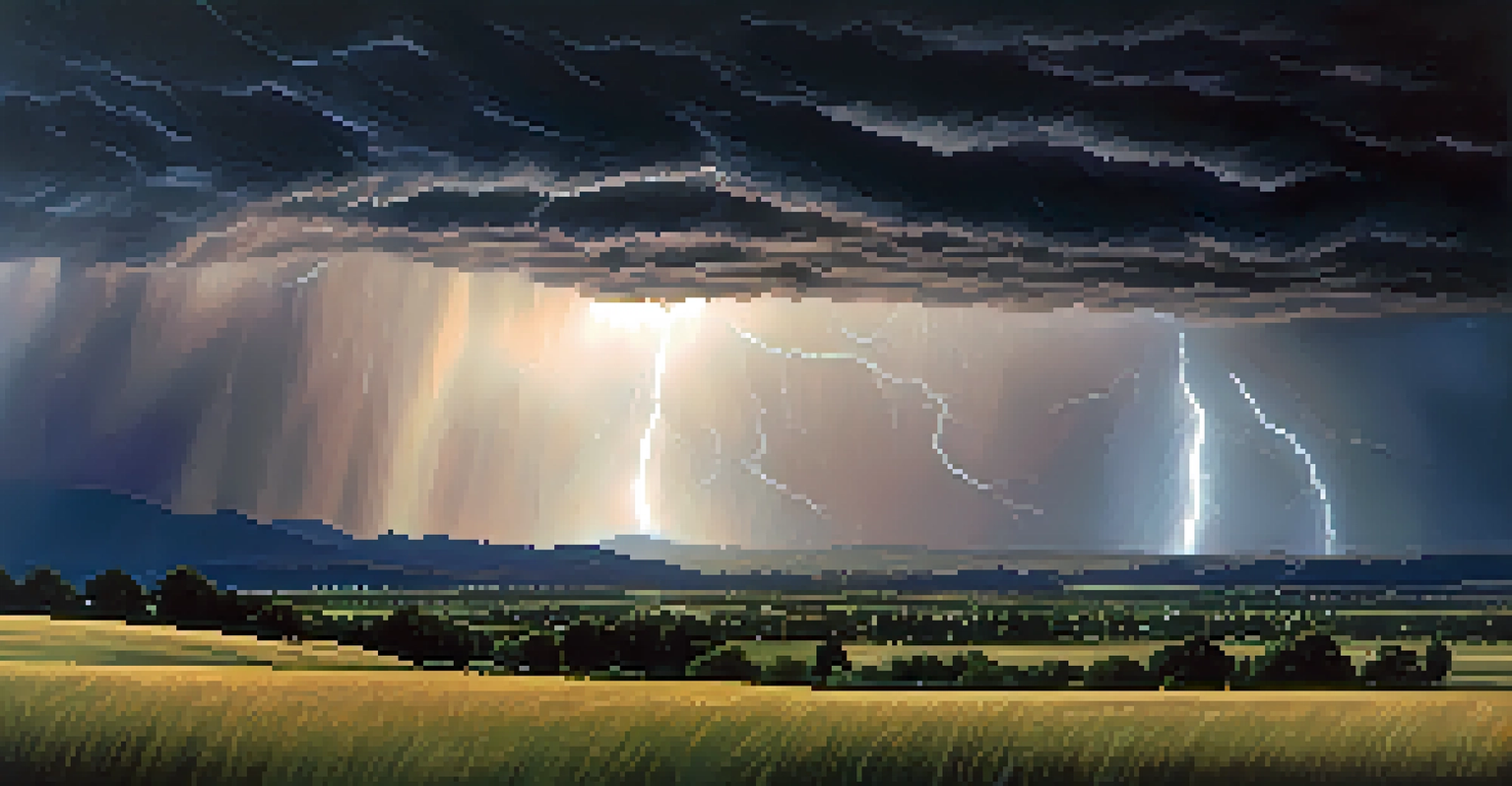The Impact of Geography on Boulder's Weather Patterns

Boulder's Unique Location and Elevation
Boulder, nestled against the foothills of the Rockies, sits at an elevation of about 5,430 feet. This altitude plays a significant role in its weather, as higher elevations typically experience cooler temperatures. The city's unique geographic location also means it is influenced by both continental and maritime air masses, creating a blend of weather systems that can be quite unpredictable.
The mountains are calling and I must go.
The proximity to the mountains means that Boulder often experiences dramatic weather changes. For instance, a sunny morning can quickly turn into a thunderstorm by afternoon, showcasing the area's dynamic climate. This shift is largely due to the orographic effect, where moist air rises over the mountains, cools, and condenses into clouds and precipitation.
Additionally, Boulder's elevation contributes to its famed 'Chinook winds,' which can lead to rapid temperature increases during winter months. These winds descend from the mountains, warming the air significantly as they move downwards, often leading to a stark contrast between local temperatures and those in nearby lower-lying areas.
The Influence of the Rocky Mountains
The Rocky Mountains act as a natural barrier for Boulder, influencing the flow of weather patterns. They block certain moisture-laden winds, leading to drier conditions on the eastern side where Boulder is situated. This geographical feature can create a rain shadow effect, making the city drier compared to areas just a few miles away on the western slopes.

Moreover, the mountains can also enhance snow accumulation in the winter months. Boulder's elevation allows it to catch more snowfall compared to lower areas, which is why residents often enjoy a snowy winter landscape. This snowfall not only impacts local weather but also feeds into water supplies during the warmer months.
Boulder's Weather Influenced by Geography
Boulder's unique location at the foothills of the Rockies and its elevation create diverse and unpredictable weather patterns.
Boulder's location at the base of the Rockies means that weather phenomena like thunderstorms are common in summer. The mountains can generate powerful updrafts, causing storm clouds to build and creating intense rainfall, hail, and lightning. For residents, this means always being prepared for sudden weather changes, particularly in the summer.
The Role of the Great Plains
To the east of Boulder lies the expansive Great Plains, which significantly influence local weather. The plains can funnel cold air masses into the area, especially during winter, leading to colder temperatures and occasional snowstorms. This interaction between the plains and the foothills creates a unique atmospheric mix that contributes to Boulder's diverse weather.
Weather is a great metaphor for life – sometimes it’s good, sometimes it’s bad, and there’s nothing much you can do about it but carry an umbrella.
Additionally, the Great Plains are known for their strong winds, which can sweep across the region and affect Boulder’s conditions. These winds can lead to temperature drops and sudden gusts, impacting outdoor activities and local events. The combination of these winds with Boulder's elevation can also result in rapid weather changes throughout the day.
The geographical contrast between the rolling plains and the rugged mountains contributes to the region's storm systems. This dynamic interplay often leads to severe weather events, such as hailstorms and thunderstorms, which are a hallmark of Boulder's summer months. Understanding this interaction is key to predicting Boulder's weather patterns.
Local Microclimates in Boulder
Boulder's topography creates a variety of microclimates throughout the city. For example, areas near the foothills may experience cooler temperatures and more precipitation than neighborhoods further east. These subtle differences can significantly affect gardening, outdoor recreation, and daily life for residents.
One interesting aspect of Boulder's microclimates is how they influence snowfall. Some neighborhoods may receive heavy snowfall, while others just a few miles away might see little to none. This variability can be attributed to elevation changes, vegetation, and proximity to the mountains, making local weather a fascinating study.
Microclimates Affect Local Conditions
The city's varied topography results in microclimates, leading to significant differences in temperature and precipitation within short distances.
Understanding these microclimates can help residents plan their outdoor activities better. Whether it's deciding when to hike or when to shovel snow, being aware of these localized weather patterns can lead to a more enjoyable experience in this beautiful city.
Seasonal Weather Variations in Boulder
Boulder's weather is characterized by clear seasonal variations that are closely tied to its geography. Winters are generally cold and snowy, thanks to the influence of the Rockies and Great Plains. Conversely, summers are typically warm and can be quite stormy, as moisture from the plains meets the warmer air rising from the city.
Spring and fall serve as transitional periods where weather can be quite unpredictable. These seasons often bear the brunt of rapid temperature changes, making it common for Boulder to experience a sunny day abruptly turning into a snowstorm. Such fluctuations are typical in a geographically diverse area like Boulder.
Residents often celebrate the arrival of spring as it brings warmer temperatures and blooming flowers. However, they also need to be mindful of the potential for late-season snowstorms, a reminder of Boulder's unpredictable weather patterns. This seasonal dance keeps life in Boulder both exciting and challenging.
The Impact of Urban Development on Weather
As Boulder has grown, urban development has begun to influence local weather patterns. The increase in concrete and asphalt creates an urban heat island effect, where temperatures in the city can be warmer than surrounding areas. This phenomenon can lead to a more pronounced temperature difference, especially during summer months.
Additionally, urban development can impact wind patterns. Buildings and structures can block or redirect winds, which may alter how weather systems move through the area. This change can affect everything from local temperatures to the frequency and intensity of storms.
Urban Development Alters Weather Patterns
As Boulder expands, urban development creates an urban heat island effect and impacts local wind and rainfall patterns.
Moreover, the expansion of urban areas may also influence local rainfall patterns. As more land is paved over, the ability of the ground to absorb water decreases, potentially leading to increased runoff during storms. Understanding these impacts is crucial for sustainable urban planning and ensuring Boulder's weather remains manageable for its residents.
Preparing for Boulder's Weather Challenges
Given Boulder's diverse weather patterns, preparation is key for residents. Understanding the unique aspects of local weather can help individuals and families make informed decisions about outdoor activities and safety measures. For instance, knowing when thunderstorms are likely can prevent unfortunate surprises during a planned hike.
Local weather apps and forecasts are invaluable tools for staying informed. Many residents rely on these resources to track changing conditions, especially during seasons known for unpredictable weather. By keeping an eye on forecasts, individuals can better prepare for sudden snowfalls or strong winds.

Community awareness is also crucial in navigating Boulder's weather challenges. By sharing experiences and tips, residents can build a support network that fosters preparedness. This collaboration not only enhances safety but also creates a sense of camaraderie among those living in this beautiful, albeit weather-variable, city.